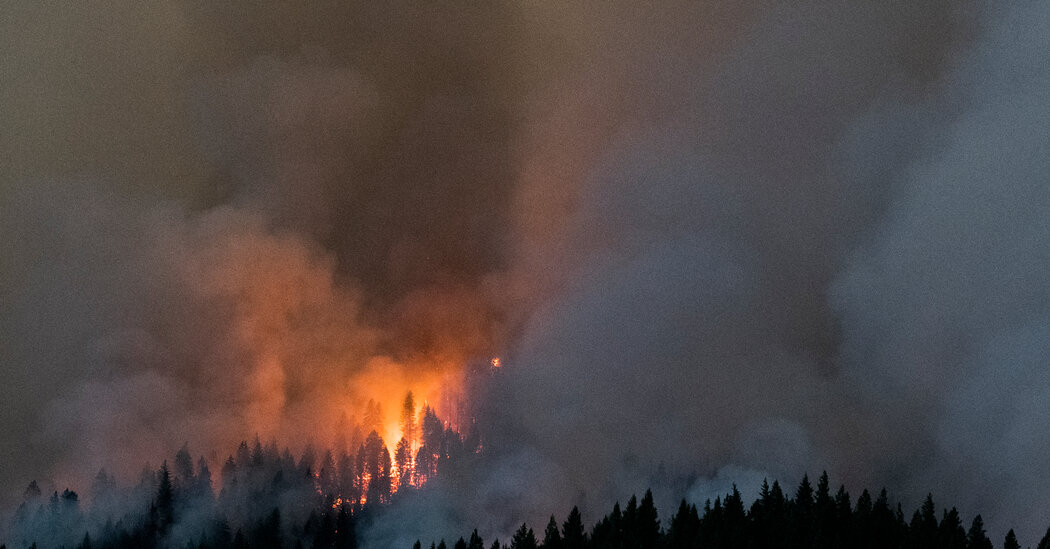
Michael Hambrick has been putting out fires for over 25 years. But last month, the Dixie Fire raged so quickly through Plumas County in California that Mr. Hambrick, a helicopter attack firefighter, couldn’t save even his own house.
By the time he evacuated, his porch was on fire, and the windows were shattering as 40-foot-tall flames whipped through his sparsely populated mountain community of Indian Falls. The wildfire blew up to a size and intensity rarely seen this early in the season, as climate change deepens a drought that is drying out the West.
“It was gut-wrenching,” said Mr. Hambrick, who lost all that he owned. He had set up three-foot-tall sprinklers around his house as a preventive measure, he said, but “the fire blew right through it like it was nothing.”
Extreme weather has gripped vast swaths of the United States this summer, with at least four major heat waves fueling fires that have filled the skies with smoke so thick it reddened the sun in New York City. And the heart of both wildfire and hurricane season is yet to come.
Here’s a look at what has happened, and what to expect.
Wildfire season got off to an early start, with giant blazes in Oregon and California.
Major fires forced thousands to flee their homes in Northern California last week, while the Bootleg Fire in Oregon that first sparked nearly a month ago continues to burn. It’s already the third-largest in the state since 1900.
Fires of this size usually don’t spread in the West until August or September. But this year, following a remarkably dry winter in much of the West, the season began as early as April, when fires in northwestern Arizona’s pine-covered mountains forced hundreds to evacuate.
Officials have offered dire warnings about the blazes yet to come.
“No corner of our state is immune,” Gov. Kate Brown of Oregon said recently, blaming “the urgent and dangerous climate crisis.”
Despite a return of monsoon rains, the Western drought is getting worse.
Monsoon rains in the desert Southwest have brought much-welcome downpours. Parts of Northern Arizona received several times more rain in July alone than they did during the entire 2020 monsoon season, which runs from June to September.
But experts say that won’t be enough to relieve the drought conditions for long.
Ninety percent of the American West is under drought conditions, with much of California and the Southwest experiencing “severe” or “exceptional” drought.
“It’s a very large deficit that these states have to make up to get back to normal — if you want to call it that,” said David Lawrence, a meteorologist with the National Weather Service. Many parts of the Southwest are short nearly a year’s worth of rainfall, he said.
Meteorologists expect the dry conditions to last through the summer, and it’s likely that they will return even if fall and winter offer a respite.
Deadly heat waves have shattered temperature records.
A heat wave roasted the Pacific Northwest in late June, breaking statewide temperature records. Many local records also have fallen as extreme temperatures have scorched through one area of the West after another.
The Weather Service predicts that much of the western and central United States will continue to see above-average temperatures for at least the next couple of weeks.
Extreme heat waves are difficult to predict more than a few days in advance, Mr. Lawrence said. But the patterns producing above-average temperatures show little sign of letting up, and heat warnings were in effect over the weekend across much of the southeastern United States and parts of the Northwest.
Wildfire smoke is creating dangerous air quality thousands of miles from the flames.
“Why is the sun red?” was a trending term on search engines in mid-July as smoke from scores of Western wildfires contributed to hazy, unhealthy air a continent away.
The air quality index, a measure developed by the Environmental Protection Agency, spiked across the Midwest and East Coast, with numbers hovering around 130 to 160 in New York City — a range that can trigger adverse health effects. (The index runs from 0 to 500, with readings over 100 considered particularly unhealthy.)
In Minnesota over the weekend, wildfire smoke from fires north of the border in Canada created air quality so dangerous that meteorologists warned people to stay indoors as much as possible. As wildfires burn more intensely, experts say smoke will continue to be a nationwide hazard.
Hurricane season got off to a swift start, bringing dangerous flash floods.
Tropical Storm Elsa flooded New York City roads and subway stations in early July. It also set this year’s storm season ahead of 2020’s record pace: It was the earliest on record that the Atlantic basin had seen a fifth named storm.
The first, Ana, formed on May 23, making this year the seventh in a row that a named storm developed in the Atlantic before the official start of hurricane season on June 1. The past couple of weeks have been quiet, but the busiest part of hurricane season usually doesn’t start until late August.
In their most recent forecast, scientists with the National Oceanic and Atmospheric Administration predicted that there would be 13 to 20 named storms this year, three to five of which would be major hurricanes of Category 3 or higher.
But experts are optimistic that cooler sea surface temperatures in the Atlantic will make this hurricane season less intense than in 2020, when there were so many named storms that meteorologists exhausted the alphabet for the second time and moved to using Greek letters.
Average Rating